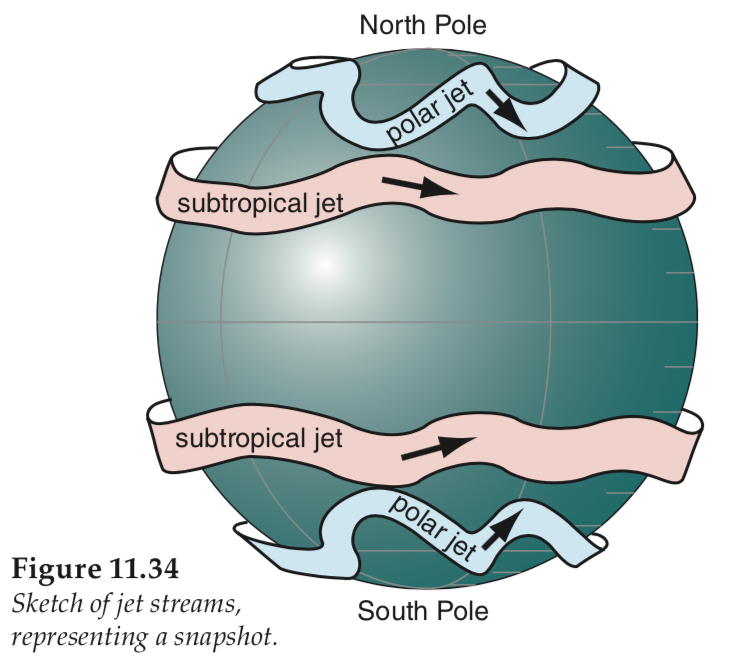The Moving Sky – Jet Streams and Climate Chaos: The Earth’s atmosphere is a dynamic system, constantly shifting and influencing weather patterns across the globe. Among its most powerful and influential features are the jet streams—narrow bands of fast-flowing air high in the troposphere. These invisible rivers of wind play a crucial role in shaping weather systems, but as climate change accelerates, they are becoming increasingly erratic. Scientists warn that disruptions in jet stream behavior could lead to more extreme weather events, prolonged heatwaves, and devastating storms, pushing the planet toward climate chaos.
What Are Jet Streams?
Jet streams are high-altitude air currents that flow from west to east, typically between 5 to 9 miles (8 to 14 kilometers) above the Earth’s surface. They form due to temperature differences between polar and tropical air masses, combined with the planet’s rotation (Coriolis effect). There are two main types:
-
Polar Jet Stream – Located near the boundary between polar and mid-latitude air, it influences weather in North America, Europe, and Asia.
-
Subtropical Jet Stream – Found closer to the equator, affecting regions like the southern U.S., North Africa, and South Asia.
These winds can reach speeds of 200 mph (320 km/h), steering storms, directing high- and low-pressure systems, and even influencing airline routes.
How Jet Streams Shape Our Weather
Jet streams act like atmospheric highways, guiding weather systems around the planet. Their position and strength determine whether a region experiences:
-
Mild, stable weather (when the jet stream flows smoothly in a straight or slightly wavy pattern).
-
Extreme weather events (when the jet stream becomes highly wavy or “stuck” in place).
A strong, stable jet stream keeps cold air confined to polar regions while allowing warm air to circulate efficiently. However, when the jet stream weakens or becomes highly meandering (known as “Rossby waves”), weather systems can stall, leading to:
-
Prolonged heatwaves (as seen in Europe in 2022 and 2023).
-
Persistent cold snaps (like the 2021 Texas freeze).
-
Intensified storms and flooding (such as the 2023 Libyan floods).
Climate Change and Jet Stream Disruption
Human-induced climate change is altering jet stream behavior in alarming ways. The Arctic is warming up to four times faster than the rest of the planet, reducing the temperature gradient that drives these winds. This phenomenon, known as Arctic Amplification, is causing the polar jet stream to:
1. Slow Down and Weaken
A weaker jet stream is less effective at containing polar air, allowing frigid Arctic blasts to plunge further south (e.g., the 2021 “Beast from the East” in Europe).
2. Become More Wavy
Increased meandering leads to blocking patterns, where weather systems remain stuck for weeks. This can cause:
-
Heat domes (like the 2021 Pacific Northwest heatwave).
-
Extended droughts (such as California’s megadrought).
-
Catastrophic rainfall (Pakistan’s 2022 floods).
3. Shift Poleward
Some studies suggest jet streams are gradually moving toward the poles, altering traditional storm tracks and rainfall patterns, leaving some regions drier and others wetter.
Real-World Consequences of a Chaotic Jet Stream
Recent years have provided stark examples of how jet stream disruptions are fueling climate chaos:
1. Europe’s “Heat Apocalypse” (2022-2023)
A stalled high-pressure system, driven by a wavy jet stream, led to record-breaking temperatures exceeding 40°C (104°F) in the UK and 47°C (117°F) in Spain, triggering wildfires and thousands of deaths.
2. The Texas Deep Freeze (2021)
A weakened polar vortex allowed Arctic air to surge deep into the U.S., collapsing Texas’ power grid and killing over 200 people.
3. Pakistan’s Biblical Floods (2022)
An unusually persistent jet stream pattern caused monsoon rains to linger, submerging a third of Pakistan and displacing 33 million people.
Is the Jet Stream Collapsing?
Some scientists warn that if Arctic warming continues unchecked, the jet stream could reach a tipping point, where its flow becomes so erratic that extreme weather becomes the norm. A 2018 study suggested that climate change could increase “stuck” weather patterns by 50%, making disasters like heatwaves and floods more frequent.
What Can Be Done?
While we cannot directly control the jet stream, mitigating climate change can help stabilize it. Key actions include:
-
Slashing greenhouse gas emissions to slow Arctic warming.
-
Transitioning to renewable energy to reduce fossil fuel dependence.
-
Strengthening infrastructure to withstand extreme weather.
Conclusion: A Warning from the Skies
The jet stream is Earth’s atmospheric heartbeat—and right now, it’s beating irregularly. As global temperatures rise, its destabilization threatens to unleash even greater climate chaos. The question is no longer if these disruptions will worsen, but how quickly we can adapt—and whether we can still prevent the worst outcomes. The moving sky is sending us a message; it’s time to listen.




